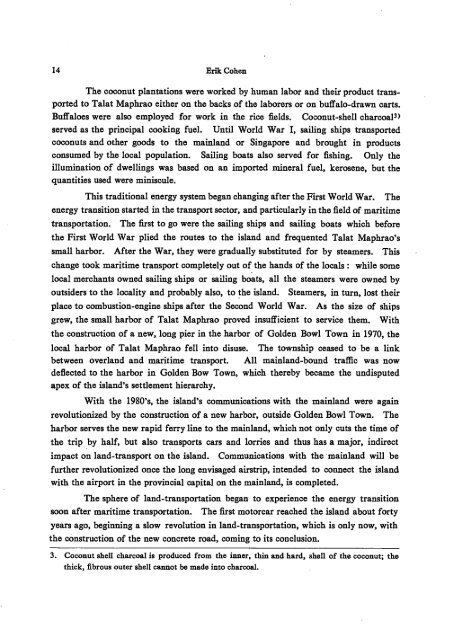The Journal of the Siam Society Vol. LXXI, Part 1-2, 1983 - Khamkoo
The Journal of the Siam Society Vol. LXXI, Part 1-2, 1983 - Khamkoo
The Journal of the Siam Society Vol. LXXI, Part 1-2, 1983 - Khamkoo
Create successful ePaper yourself
Turn your PDF publications into a flip-book with our unique Google optimized e-Paper software.
14 Erik Cohen<br />
<strong>The</strong> coconut plantations were worked by human labor and <strong>the</strong>ir product transported<br />
to Talat Maphrao ei<strong>the</strong>r on <strong>the</strong> backs <strong>of</strong> <strong>the</strong> laborers or on buffalo-drawn carts.<br />
Buffaloes were also employed for work in <strong>the</strong> rice fields. Coconut-shell charcoaP)<br />
served as <strong>the</strong> principal cooking fuel. Until World War I, sailing ships transported<br />
coconuts and o<strong>the</strong>r goods to <strong>the</strong> mainland or Singapore and brought in products<br />
consumed by <strong>the</strong> local population. Sailing boats also served for fishing. Only <strong>the</strong><br />
illumination <strong>of</strong> dwellings was based on an imported mineral fuel, kerosene, but <strong>the</strong><br />
quantities used were miniscule.<br />
This traditional energy system began changing after <strong>the</strong> First World War. <strong>The</strong><br />
energy transition started in <strong>the</strong> transport sector, and particularly in <strong>the</strong> field <strong>of</strong> maritime<br />
transportation. <strong>The</strong> first to go were <strong>the</strong> sailing ships and sailing boats which before<br />
<strong>the</strong> First World War plied <strong>the</strong> routes to <strong>the</strong> island and frequented Talat Maphrao's<br />
small harbor. After <strong>the</strong> War, <strong>the</strong>y were gradually substituted for by steamers. This<br />
change took maritime transport completely out <strong>of</strong> <strong>the</strong> hands <strong>of</strong> <strong>the</strong> locals : while some<br />
local merchants owned sailing ships or sailing boats, all <strong>the</strong> steamers were owned by<br />
outsiders to <strong>the</strong> locality and probably also, to ~e island. Steamers, in turn, lost <strong>the</strong>ir<br />
place to combustion-engine ships after <strong>the</strong> Second World War. As <strong>the</strong> size <strong>of</strong> ships<br />
grew, <strong>the</strong> small harbor <strong>of</strong> Talat Maphrao proved insufficient to service <strong>the</strong>m. With<br />
<strong>the</strong> construction <strong>of</strong> a new, long pier in <strong>the</strong> harbor <strong>of</strong> Golden Bowl Town in 1970, <strong>the</strong><br />
local harbor <strong>of</strong> Talat Maphrao fell into disuse. <strong>The</strong> township ceased to be a link<br />
between overland and maritime transport. All mainland-bound traffic was now<br />
deflected to <strong>the</strong> harbor in Golden Bow Town, which <strong>the</strong>reby became <strong>the</strong> undisputed<br />
apex <strong>of</strong> <strong>the</strong> island's settlement hierarchy.<br />
With <strong>the</strong> 1980's, <strong>the</strong> island's communications with <strong>the</strong> mainland were again<br />
revolutionized by <strong>the</strong> construction <strong>of</strong> a n~w harbor, outside Golden Bowl Town. <strong>The</strong><br />
harbor serves <strong>the</strong> new rapid ferry line to <strong>the</strong> mainland, which not only cuts <strong>the</strong> time <strong>of</strong><br />
<strong>the</strong> trip by half, but also transports cars and lorries and thus has a major, indirect<br />
impact on land-transport on <strong>the</strong> island. Communications with <strong>the</strong> ·mainland will be<br />
fur<strong>the</strong>r revolutionized once <strong>the</strong> long envisaged airstrip, intended to connect <strong>the</strong> island<br />
with <strong>the</strong> airport in <strong>the</strong> provincial capital on <strong>the</strong> mainland, is completed.<br />
<strong>The</strong> sphere <strong>of</strong> land-transportation began to experience <strong>the</strong> energy transition<br />
soon after maritime transportation. <strong>The</strong> first motorcar reached <strong>the</strong> island about forty<br />
years ago, beginning a slow revolution in land-transportation, which is only now, with<br />
<strong>the</strong> cOnstruction <strong>of</strong> <strong>the</strong> new concrete road, coming to its conclusion.<br />
3. Coconut shell charcoal is produced from <strong>the</strong> inner, thin and hard, shell <strong>of</strong> <strong>the</strong> coconut; <strong>the</strong><br />
thick, fibrous outer shell cannot be made into -charcoal.

















